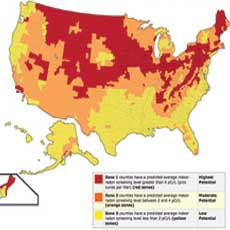


Radon is a radioactive gas. It comes from the natural decay of uranium that is found in nearly all soils. It typically moves up through the ground to the air above and into your home through cracks and other holes in the foundation. Your home traps radon inside, where it can build up. Any home may have a radon problem. This means new and old homes, wellsealed and drafty homes, and homes with or without basements. Radon from soil gas is the main cause of radon problems.

The U.S. Environmental Protection Agency (US EPA) and the Surgeon General’s Office have estimated that as many as 20,000 lung cancer deaths are caused each year by radon. Radon is the second leading cause of lung cancer. Radon-induced lung cancer costs the United States over $2 billion dollars per year in both direct and indirect health care costs. (Based on National Cancer Institute statistics of 14,400 annual radon lung cancer deaths – Oster, Colditz & Kelley, 1984)
According to the US EPA, nearly 1 in 3 homes checked in seven states and on three Indian lands had screening levels over 4 pCi/L, the EPA’s recommended action level for radon exposure.
The alpha radiation emitted by radon is the same alpha radiation emitted by other alpha generating radiation sources such as plutonium.
A family whose home has radon levels of 4 pCi/l is exposed to approximately 35 times as much radiation as the Nuclear Regulatory Commission would allow if that family was standing next to the fence of a radioactive waste site. (25 mrem limit, 800 mrem exposure)
An elementary school student that spends 8 hours per day and 180 days per year in a classroom with 4 pCi/l of radon will receive nearly 10 times as much radiation as the Nuclear Regulatory Commission allows at the edge of a nuclear power plant.(25 mrem limit, 200 mrem exposure)
Most U.S. EPA lifetime safety standards for carcinogens are established based on a 1 in 100,000 risk of death. Most scientists agree that the risk of death for radon at 4 pCi/l is approximately 1 in 100. At the 4 pCi/l EPA action guideline level, radon carries approximately 1000 times the risk of death as any other EPA carcinogen. It is important to note that the action level is not a safe level, as there are no “safe” levels of radon gas.
Radon is a cancer-causing radioactive gas. You cannot see, smell or taste radon, but it may be a problem in your home. The Surgeon General has warned that radon is the second leading cause of lung cancer in the United States today. If you smoke and your home has high radon levels, you’re at high risk for developing lung cancer. Some scientific studies of radon exposure indicate that children may be more sensitive to radon. This may be due to their higher respiration rate and their rapidly dividing cells, which may be more vulnerable to radiation damage.
PROPERTIES: Radon is a gaseous highly radioactive element discovered by English physicist Ernest Rutherford in 1899. The discovery is also credited to German physicist Friedrich Ernst Dorn in 1900. More specifically, Rutherford discovered radon’s alpha radiation and Dorn discovered that radium was releasing a gas.
Radon is a colorless chemically-unreactive inert gas. The atomic radius is 1.34 angstroms and it is the heaviest known gas–radon is nine times denser than air. Because it is a single atom gas (unlike oxygen, O2, which is comprised of two atoms) it easily penetrates many common materials like paper, leather, low density plastic (like plastic bags, etc.) most paints, and building materials like gypsum board (sheetrock), concrete block, mortar, sheathing paper (tarpaper), wood paneling, and most insulations.
Radon is also fairly soluble in water and organic solvents. Although reaction with other compounds is comparatively rare, it is not completely inert and forms stable molecules with highly electronegative materials. Radon is considered a noble gas that occurs in several isotopic forms. Only two are found in significant concentrations in the human environment: radon-222, and radon-220. Radon-222 is a member of the radioactive decay chain of uranium-238. Radon-220 is formed in the decay chain of thorium-232. Radon-222 decays in a sequence of radionuclides called radon decay products, radon daughters, or radon progeny. It is radon-222 that most readily occurs in the environment. Atmospheric releases of radon-222 results in the formation of decay products that are radioisotopes of heavy metals (polonium, lead, bismuth) and rapidly attach to other airborne materials such as dust and other materials facilitating inhalation.
USE: Radon has been used in some spas for presumed medical effects. In addition, radon is used to initiate and influence chemical reactions and as a surface label in the study of surface reactions. It has been obtained by pumping the gases off of a solution of a radium salt, sparking the gas mixture to combine the hydrogen and oxygen, removing the water and carbon dioxide by adsorption, and freezing out the radon.
PRODUCTION: Radon is not produced as a commercial product. Radon is a naturally occurring radioactive gas and comes from the natural breakdown (radioactive decay) of uranium. It is usually found in igneous rock and soil, but in some cases, well water may also be a source of radon.
EXPOSURE: The primary routes of potential human exposure to radon are inhalation and ingestion. Radon in the ground, groundwater, or building materials enters working and living spaces and disintegrates into its decay products. Although high concentrations of radon in groundwater may contribute to radon exposure through ingestion, the inhalation of radon released from water is usually more important.
RADON IN THE WORKPLACE: In comparison with levels in outdoor air, humans in confined air spaces, particularly in underground work areas such as mines and buildings, are exposed to elevated concentrations of radon and its decay products. Exhalation of radon from ordinary rock and soils and from radon-rich water can cause significant radon concentrations in tunnels, power stations, caves, public baths, and spas. The average radon concentrations in houses are generally much lower than the average radon concentrations in underground ore mines.
Workers are exposed to radon in several occupations. In countries for which data were available, concentrations of radon decay products in underground mines are now typically less than 1000 Bq/m3 EEC Rn (approx. 28 pCi/l). Underground uranium miners are exposed to the highest levels of radon and its decay products. Other underground workers and certain mineral processing workers may also be exposed to significant levels.
Testing is the only way to know your home’s radon levels. There are no immediate symptoms that will alert you to the presence of radon. It typically takes years of exposure before any problems surface.
The US EPA, Surgeon General, American Lung Association, American Medical Association, and National Safety Council recommend testing your home for radon because testing is the only way to know your home’s radon levels. There are no immediate symptoms that will alert you to the presence of radon. It typically takes years of exposure before any problems surface.
Radon is a national environmental health problem. Elevated radon levels have been discovered in every state. The US EPA estimates that as many as 8 million homes throughout the country have elevated levels of radon. Current state surveys show that 1 home in 5 has elevated radon levels.
If your home has high concentrations of radon there are ways to reduce it to acceptable levels. Most radon problems can be fixed by a do-it-yourselfer for less than $500. If you want or require the assistance of a professional you may wish to look at the list of certified radon mitigators for your state.
All Around Inspection
Phone: 847.471.7313
Home Inspection: Service Request
Member of:



*$4 service fee added for credit cards